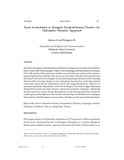Please use this identifier to cite or link to this item:
https://cris.library.msu.ac.zw//handle/11408/685| Title: | Nasal assimilation in Shangwe nasal-obstruent clusters: an optimality theoretic approach | Authors: | Jakaza, Ernest Mangeya, Hugh |
Keywords: | Nasal- obstruent cluster, assimilation, dialect, language varieties, Shangwe, Korekore, Shona, optimality theory | Issue Date: | 2014 | Publisher: | Midlands State University | Series/Report no.: | The Dyke;Vol. 8, No. 2; p. 20-36 | Abstract: | The article investigates nasal-obstruent assimilation in Shangwe (a sub-dialect of the Korekore dialect cluster of the Shona language). Studies on the phonology of the Shona dialect (c.f. Fortune, 1972, 1980; Guthrie, 1948) cluster have tended to treat the behaviour of the nasal in sequences manifesting the pattern /NuOb/ as the same across the cluster. This article demonstrates that after Nasal-vowel deletion in Shangwe the nasal homorganically assimilates to the remaining obstruent that it precedes. Studies on the outstanding characteristics of the Shona dialect cluster have shown that the Shona dialect cluster has many idiosyncrasies. However no systematic and holistic study has been carried out on Shangwe. The research engages Optimality Theory (OT) to explore the nature of nasal- obstruent assimilation in Shangwe. Optimality Theory is used to account for the fact that differences in the ranking of universal constraints results in grammatical differences. The research is based on tape recorded interviews of Shangwe informants from Chief Nemangwe’s area in Gokwe. The data was then transcribed and analysed. | URI: | http://hdl.handle.net/11408/685 | ISSN: | 1815-9036 |
| Appears in Collections: | Research Papers |
Files in This Item:
| File | Description | Size | Format | |
|---|---|---|---|---|
| mangeya.pdf | 255.1 kB | Adobe PDF |  View/Open |
Page view(s)
110
checked on Dec 7, 2025
Download(s)
38
checked on Dec 7, 2025
Google ScholarTM
Check
Items in MSUIR are protected by copyright, with all rights reserved, unless otherwise indicated.



